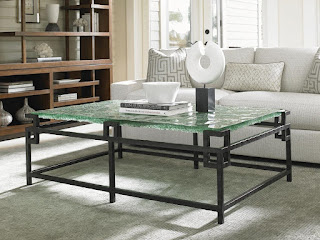1. Two-Dimensional and Three-Dimensional Space
Space forms the foundation on which an interior design plan rests. Therefore, it is important to know the space’s dimensions and function. Space is delineated in two ways: two-dimensional space and three-dimensional space. Two-dimensional space refers to the length and width of the floor and three-dimensional space refers to the length, width, and height of the entire living space. Within these divisions are the elements of positive space and negative space. Positive space is filled with furniture and décor items, while negative space is empty. Balancing positive and negative space is essential to creating equilibrium. This means that you want to avoid overcrowding the space with furniture and, conversely, not adding enough furniture and décor. Above, the Criteria Queen Upholstered Bed by Bernhardt grounds the space without overpowering the room. Upholstered in a warm and contemporary light gray fabric with decorative nailhead accents, it adds a touch of drama and elegance to an otherwise sterile-looking space.2. Lines Provide Grounding, Movement, and Drama
Lines create shapes and forms, and establish a sense of cohesion and contrast in a living space. Lines are defined as three types: horizontal, vertical, and dynamic. Horizontal lines ground the space, while vertical lines create a free and expansive feeling in a space. Horizontal lines define structures such as chairs, tables, beds, and tables. Vertical lines are found on windows, doors, cabinets and armoires.Angular lines are dynamic, adding a sense of motion and drama to a room. They are found on structures such as vaulted ceilings and archways.
3. Forms Establish Harmony and Balance
Forms in interior design refer to the outline of three-dimensional objects in a room. Forms can be a combination of two or more shapes and are often highlighted by other elements such as patterns, texture, and color. A well-designed room uses forms to bring harmony and balance to the space.Forms are either geometric (man-made) or natural (organic) and can be closed or open. Closed forms are enclosed while open forms can be looked into. A basic understanding of space and line will help you achieve a good form.
4. Light Highlights Special Pieces
Light is an important yet often overlooked element of interior design. Whether natural or man-made, if there is no light, the other elements such as color, pattern, and texture have no significance. Light helps highlight every design element, including line, space, and form. Beyond this, the right light will set the mood, create ambiance, and make living spaces functional.Windows and doors are the sources of natural light. Well-placed windows can flood a space with natural light. Artificial or man-made lighting is divided into three categories: mood lighting, task lighting, and accent lighting.
Mood lighting, also called ambient lighting, sets the tone of the space. Task lighting includes bed and table lamps that have a specific purpose, such as reading. Accent lighting spotlights a particular feature such as artwork, structures, and sculptures.
5. Color Creates a Connection between Objects
The color palette establishes an aesthetic connection between objects in the space. For example, if you have two pieces of furniture of different styles, you unite them with color. In addition, colors evoke feelings and moods, and you can use that when you choose colors for your rooms.Each color has three characteristics: hue, value, and intensity. Colors are classified into primary and secondary, with sub-categories of tertiary, complementary, and analogous. These characteristics are used to mix into various color combinations, including monochromatic color schemes.
6. Texture Makes It Interesting
Texture in the broadest sense refers to how a surface looks and feels. It serves to add interest and depth to a living space and also to define the feel and appearance of surfaces. It is classified into two types: visual texture and actual texture. Visual texture is only seen, while actual texture can be both seen and felt.Textiles such as pillow covers, bedspreads, and drapes as well as wall paint or wallpapers have a texture. The dominant texture defines the mood of the space while adding contrasting texture helps avoid monotony in a space.
In this room featuring the Modern Brando Bed from Universal, the monochromatic color palette comes alive with faux fur upholstery in the end-of-bed bench, a little shimmer from the metal embellishments on the furniture, and visual interest from the stone walls.
7. Patterns Hold the Design Together
Patterns work with colors and texture to liven up interior design. They add continuity in a living space. Patterns can be of almost any shape and feature repetitive and attractive designs.Find more design inspiration and read Baer's Furniture reviews on Houzz. Baer's Furniture exec discusses the importance of buying quality furniture.






